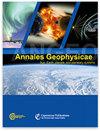6D 磁层混合动力模拟得出的大气奇氮对电子强迫的响应
IF 1.9
4区 地球科学
Q3 ASTRONOMY & ASTROPHYSICS
引用次数: 0
摘要
摘要对极地中高层大气中的奇氮(NOx)分布进行建模是一项复杂的任务。首先,高能电子沉淀产生的氮氧化物在小时时间尺度上变化很大。其次,目前大气和气候模式中使用的基于测量但经过简化的电子通量数据集存在不确定性。在月时间尺度上,氮氧化物的高度分布也受到大气动力学的强烈影响,特别是在极地冬季,极地涡旋内的孤立空气从低温层下降到中间层和平流层。最近对测量结果和模拟结果进行的比较显示,氮氧化物的分布存在很大差异,模型中对其产生和传输的表述仍然存在问题。在这里,我们首次提出了一种新方法,即从磁层混合动力学模拟中得出极光能量范围(50 eV-50 keV)内的电子大气强迫,并详细描述了能量范围和分辨率以及空间和昼夜分布。这些电子数据被用作全球整体大气模型的输入,以研究对极地氮氧化物和臭氧的影响。我们将证明,磁层电子数据真实地反映了对低热层、中间层和平流层产生巨大影响的强迫。我们发现,在极地冬季,与大气模型中没有极光电子强迫相比,模拟的极光电子降水会使热大气层下部、中间层和平流层上部的极地氮氧化物浓度分别增加 200%、50% 和 7%。这些结果证明了将磁层和大气模拟结合起来进行太阳风-大气耦合详细研究的潜力。本文章由计算机程序翻译,如有差异,请以英文原文为准。
Atmospheric odd nitrogen response to electron forcing from a 6D magnetospheric hybrid-kinetic simulation
Abstract. Modelling the distribution of odd nitrogen (NOx) in the polar middle and upper atmosphere has proven to be a complex task. Firstly, its production by energetic electron precipitation is highly variable on hourly time scales. Secondly, there are uncertainties in the measurement-based but simplified electron flux data sets that are currently used in atmosphere and climate models. The altitude distribution of NOx is strongly affected by atmospheric dynamics also on monthly time scales, particularly in the polar winter periods when the isolated air inside the polar vortex descends from lower thermosphere to mesosphere and stratosphere. Recent comparisons between measurements and simulations have revealed strong differences in the NOx distribution, with questions remaining about the representation of both production and transport in models. Here we present for the first time a novel approach, where the electron atmospheric forcing in the auroral energy range (50 eV–50 keV) is derived from a magnetospheric hybrid-kinetic simulation with a detailed description of energy range and resolution, and spatial and diurnal distribution. These electron data are used as input in a global whole atmosphere model to study the impact on polar NOx and ozone. We will show that the magnetospheric electron data provides a realistic representation of the forcing which leads to considerable impact in the lower thermosphere, mesosphere and stratosphere. We find that during the polar winter the simulated auroral electron precipitation increases the polar NOx concentrations up to 200 %, 50 %, and 7 % in the lower thermosphere, mesosphere, and upper stratosphere, respectively, when compared to no auroral electron forcing in the atmospheric model. These results demonstrate the potential of combining magnetospheric and atmospheric simulations for detailed studies of solar wind – atmosphere coupling.
求助全文
通过发布文献求助,成功后即可免费获取论文全文。
去求助
来源期刊

Annales Geophysicae
地学-地球科学综合
CiteScore
4.30
自引率
0.00%
发文量
42
审稿时长
2 months
期刊介绍:
Annales Geophysicae (ANGEO) is a not-for-profit international multi- and inter-disciplinary scientific open-access journal in the field of solar–terrestrial and planetary sciences. ANGEO publishes original articles and short communications (letters) on research of the Sun–Earth system, including the science of space weather, solar–terrestrial plasma physics, the Earth''s ionosphere and atmosphere, the magnetosphere, and the study of planets and planetary systems, the interaction between the different spheres of a planet, and the interaction across the planetary system. Topics range from space weathering, planetary magnetic field, and planetary interior and surface dynamics to the formation and evolution of planetary systems.
 求助内容:
求助内容: 应助结果提醒方式:
应助结果提醒方式:


